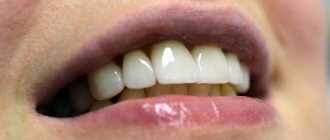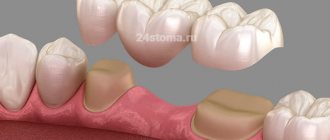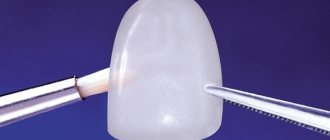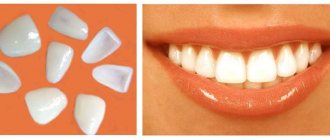It’s easy to become the owner of a snow-white smile these days. All you need to do is use dental services and install veneers. These are thin plates on the front surface of the tooth that maximally imitate the properties and appearance of natural enamel. This smile is designed to bring joy for many years, but sometimes situations arise when the fillings need to be removed. How are veneers removed and what happens to the teeth after that?
Veneers are divided into 2 types: composite and ceramic. Composite veneers are made from the same material as fillings. Ceramic ones are varied in composition. These include glass ceramics, feldspar-based alloys, and polycrystals.
Porcelain veneers
Porcelain plates are visually indistinguishable from the enamel of a normal tooth. Therefore, ordinary people will never guess about the installed records.
The advantages of ceramic crowns are that they are resistant to stress and practically do not stain.
Porcelain microprostheses are made using two methods:
1. Pressed ceramics - the material is applied in layers, then each layer is fired. In this case, the teeth are not ground down.
2. Pressed material – ceramic material is pressed under pressure and then fired at high temperatures. This method is used to achieve the strongest possible structure.
How to make porcelain veneers is decided by the doctor, based on the individual characteristics of the patient.
Plus, the service life of ceramic restorations is more than 20 years. If you decide to put veneers or crowns on your teeth, follow hygiene procedures.
where to go
| Clinic | Address | Price |
| Belgravia Dental Studio | Addresses of branches on the website. T + | From 67,000 rub. |
| Frau Clinic | St. Gilyarovskogo 55 (499) 322-05-18 | From 45,000 rub. |
| MCDI ROOT | Volgogradsky Prospekt 4A +7(800)200-79-50 | From RUR 37,000 |
| Seline | B. Kondratyevsky Lane 7 (499) 444-31-98 | From 38,000 rub. |
| Family dentistry | St. Marshala Rybalko, 2, building 3. (499) 322-22-71 | From 40,000 rub. |
Before making your final choice of clinic, find out more about the doctors. Consider the work “before” and “after”. Make sure consumables are certified. A smile is important.
E-max ceramic veneers and zirconium dioxide
Metal-free veneers contain a frame made of lithium disilicate or zirconium dioxide. Such plates are almost transparent and have a fine structure. And unlike others, their service life increases to 25–30 years.
Pros of ceramic zirconium veneers
• Duration of operation is longer than that of porcelain;
• Lithium disilicate plates look natural, regardless of lighting;
• Color does not change after eating food coloring;
• Do not accumulate plaque if the rules of oral hygiene are ignored;
• Does not have a black coating when smoking;
• They are light in weight and thin, so wear off of the enamel is minimal.
Zirconium veneers, unlike composite plates, are placed on teeth, even in the most difficult clinical cases. Usually, they are inserted in the smile zone - on the 10 upper and 8 lower teeth.
The downside is that the insertion process takes longer due to the fact that the material is difficult to fix on the tooth surface.
Installation requires minor tooth grinding.
Replacement steps
After removing the veneers, the surface of the teeth is cleaned of cement residues. If necessary, dental treatment is performed before veneers are replaced. In most cases, additional preparation (enamel removal) is not required. The process of replacing veneers with new ones follows the same algorithm as the initial installation:
- taking an impression;
- color selection;
- installation of temporary overlays;
- production of veneers;
- fixation.
Composite veneers (componeers)
They are made from filling material in two ways and differ in how veneers are placed on the teeth:
1. Aesthetic filling (therapeutic) - installation occurs in one stage. Specialist. Using equipment, the doctor polishes the front side of the tooth. Then filling material is applied to this plane. Apply as thin a layer as possible. This method can hide only minor aesthetic problems.
2. Production of composite plates in a dental laboratory using special impressions. Before installing veneers on the front teeth, the dentist grinds down the enamel. The process requires several steps, so the implants are fixed at subsequent appointments.
The downside is that the service life of composite veneers is 5 years. A significant disadvantage is also a change in the color of the plates - darkening of the cladding.
Crowns
A crown is a structure that restores or replaces the crown part of a tooth. Regardless of the material from which the structure is made, the crown covers the tooth completely (front teeth on two sides, chewing teeth on four, including the chewing surface). The main purpose of installing a crown is to treat the tooth and restore its chewing function. Using a crown, teeth that are more than 55% damaged can be restored. At the same time, the crown complements the aesthetics of the appearance. Before installing the restoration material, the tooth is ground down.
Thus, the main differences between veneers and crowns are the installation method and the main functions.
Indications for installation of veneers
1. People who were unable to achieve the desired teeth color.
2. Darkening of the tooth enamel occurred due to a filling made with formaldehyde paste, or when a nerve was removed.
3. Old fillings that have changed their color and differ from tooth enamel.
4. They are given to people who have diastemas, trema, and chips.
5. When the teeth have an irregular anatomical shape (wedge-shaped).
6. The patient has diseases - this could be enamel erosion, necrosis, hypoplasia, etc.
Rehabilitation period and care
During the recovery process, the following recommendations should be followed:
- avoid too hot or cold food and drinks;
- at the time of addiction, give up solid foods;
- use an electric toothbrush and irrigators;
- do not use threads or toothpicks;
Basic rules for caring for microprostheses:
- brush your teeth with special pastes with a gentle cleansing effect, do not use abrasive whitening agents;
- do not carry out any whitening procedures on your own, at home;
- regularly use special rinses during oral care that help strengthen the gums and have an antiseptic effect;
- Visit the dentist regularly, at least twice a year.
Who are veneers contraindicated for?
People who have the following diseases and problems are not recommended to get implants.
• The presence of a dental anomaly “bruxism” is a forceful clenching of the jaws during sleep.
• Insufficient amount of tooth enamel.
• Bite pathology, meaning straight, deep bite.
• Caries and its complications.
• A group of diseases that are characterized by inflammatory processes - gingivitis, periodontal disease, etc. These diseases are a temporary contraindication. After treatment, the structures are successfully installed.
• Severe tooth fragility, or the presence of a bulky filling.
Contraindications
The patient will be denied the procedure if at least one of the following contraindications is present:
- extensive progressive caries , as well as pathology, accompanied by an abscess or periodontitis;
- looseness of the dentition or its individual fragments;
- excessively thin outer surface of the enamel and its external damage;
- bruxism;
- partial eruption of the organ;
- direct malocclusion.
It is worth noting that the only possible way to correct existing defects with such anomalies is orthopedic crowns.
All about the diagnostic approach and treatment of candidal stomatitis using traditional and non-traditional methods. Read reviews about the Panasonic ew 1211 irrigator here.
At this address https://dr-zubov.ru/ortodontiya/apparaty/kappy/kak-vyrovnyat-zuby-bez-breketov.html you will learn how to straighten your front teeth without braces.
Veneers and Lumineers, and how they differ
Lumineers are crowns made from special dental porcelain.
Lumineers are produced by the American company, which has developed and patented the specific composition of dental porcelain and production technology. This company produces lumineers in California. Therefore, the production of such micro prostheses takes about 30 days.
The word lumineers comes from the Latin word “lumen”, which literally means “light”. The creators of lumineers claim that your teeth will become much whiter. This means that the client will receive a “Hollywood smile”. However, veneers are not much inferior to lumineers. The latter can be distinguished rather by their “luminous effect”, but otherwise they are simply an analogue of ceramic veneers.
A significant advantage of lumineers is the thickness of the plate. It is: 0.2 - 0.3 mm, and the thickness of the veneers: from 0.2 mm. up to 0.8 mm., therefore, lumineers are installed without preliminary turning, just like veneers. The impression is made directly from the tooth.
Teeth after lumineers
Lumineers can serve you for quite a long time (up to 15 years), and to remove them you need certain indications. For example, functional, when the veneer came off, broke or cracked, or aesthetic, if you wanted to improve your smile.
In these cases, it will be necessary to remove the non-prep porcelain veneers and do all the installation work again. When removing lumineers, the enamel layer is also worn down a little more. In rare cases, a new veneer can be glued on top of the old layer, thereby causing less trauma to the tooth.
Preparatory process
1. Hygienic teeth cleaning, plaque removal.
2. Grind down a thin layer of enamel, from 0.5 to 0.7 mm.
3. A harmonious shade is selected.
4. The remaining enamel is coated with a special acid.
5. An impression is made.
6. The tooth plate is carefully polished and onlays are inserted.
A thin layer of enamel is ground off in order to achieve the most harmonious and natural look. They also grind it in order to insert and firmly strengthen the plate.
It was and became: pictures of treatment results
Overlapping three, giving all teeth a standard shape.
Restoration of the entire upper row affected by isthmus caries. Several problems were solved at once: chips were closed and the shape of each tooth was aligned.
Photo: Lumineers
Photo: componeers
Photo: solving problems with three
The process of installing permanent veneers
Permanent microprostheses are placed at the second appointment. First, the orthopedist visually assesses how suitable the finished model is:
- According to the form;
— By color;
- According to the tightness of fit to the surface of the tooth.
When the dentist is convinced that the characteristics are correct, the onlays are installed.
1. The finished structure is fitted.
2. Then they control the accuracy and tightness of the fit.
3. The procedure is completed with fixation of microprostheses.
But is it still possible in some cases?
All cases are individual, so the final decision can only be made at an appointment with a doctor. It is indeed possible to hide slight crooked teeth with the help of veneers - if it is not associated with an incorrect bite. We are talking literally about 1–2 millimeters. By choosing the shape of the plates, you can level out tooth rotation. If one tooth is slightly pushed back relative to the others, a veneer that is slightly thicker than the others can be installed on it. Also, with the help of veneers it is easy to hide a small diastema.
A slight curvature can be hidden, a very pronounced one cannot.
It must be said that mildly expressed defects in the position of teeth can easily be corrected with the help of aligners in just a few months. You will not have to install braces, and the treatment will be completely invisible to others. If you like the shape and color of your teeth and the enamel has no flaws (fluorosis, stains, darkening), then orthodontic treatment will give an equally attractive result. In addition, there will be no need to grind down healthy teeth.
In any case, if the teeth are positioned incorrectly, it is best not to hide it, but to have it treated by an orthodontist, eliminating the underlying problem. And then move on to aesthetic procedures. If you carry out treatment in this order, the result will be the best possible.
Is it possible to get veneers without grinding teeth?
In order to avoid grinding down the enamel, veneers made from feldspar and E-max should be inserted; they are thinner and do not require such a procedure.
It is possible to refuse turning if:
1. You have uneven teeth;
2. If the teeth are heavily worn;
3. It is necessary to change the direction of a crooked tooth;
4. It is necessary to add volume to the tooth.
There are no ideal teeth, so veneers without grinding cannot yet be placed. Except if the teeth are sparse and not voluminous. Grinded teeth can no longer be restored in the future, so you will always need to install crowns or their equivalents.
Is it possible to shoot and in what cases?
Veneers can be removed if necessary. Teeth onlays are installed for patients who have aesthetic defects in the enamel - darkening, chips, cracks, fillings in visible areas. Using artificial material, you can disguise defects and get a perfect smile.
On a note!
Veneers mean snow-white, straight, shiny and attractive teeth. It is rare that a patient wants to permanently remove correction plates from their teeth. Most often, removing the plate is required in order to replace it with a new one.
There are real indications for which dentists advise removal.
- The material is worn out. The service life of the plates depends on the material from which they are made. Zirconium is considered the most durable. The most short-lived ones are composite ones. The latter can change their appearance after 2-3 years. This will cause the overlays to become visible to the naked eye.
- Violation of integrity. If used incorrectly, damage may occur - chipping or cracking. Therefore, after installation, dentists warn all patients not to chew nuts and hard vegetables. Bruxism can damage the pads. Chips cannot be repaired without removing the plate. In this case, the entire veneer will need to be replaced.
- Development of caries. Before veneering, all teeth must be treated. If this is not done, then hidden pathologies will progress. Carious cavities may form under the onlay, which will require removal of material for complex treatment.
- Poor installation. Veneers that are too large or small can cause discomfort. If at first the patient tries to come to terms with the unpleasant sensations, then in the future he will still be forced to seek help and remove the pads.
What happens to the teeth under the structure?
When the stitching is carried out correctly, and the design of the micro prosthesis is installed correctly, then nothing happens. However, if a plate, for example a composite, is not fixed tightly, caries or plaque accumulation may appear in such areas.
In case of plate defects, it is necessary to restore the micro prosthesis.
The downside is that it is impossible to remove the veneers; only the structure is replaced.
Most dentists provide a one-year warranty after installing the onlays.
Microprostheses on fangs
For many people, their self-confidence depends on how good their smile looks. Often, by nature, fangs are curved or protrude to the side. This creates inconvenience and provokes the development of complexes. In such situations, it is possible to install aesthetic overlays on the fangs.
The photos below show how much the situation can be improved.











